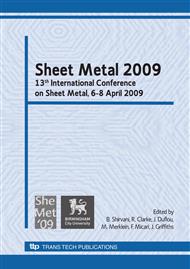p.335
p.347
p.355
p.365
p.373
p.381
p.391
p.401
p.413
On a Simplified Model for the Tool and the Sheet Contact Conditions for the SPIF Process Simulation
Abstract:
The numerical simulation of the Single Point Incremental Forming process (SPIF) is time consuming due to the necessity to take into account various non-linearity such as the material behaviour, large strain deformation and the evolution of the tool-flange contact. Classical contact algorithms give good agreement with experimental results, but are time consuming. In this paper, we investigate the development of a procedure to simplify the management of the contact interface between the tool and the sheet. Nodes with imposed displacements are determined by a geometrical approximation of the deformed sheet. In order to have a better approximation of the local stresses in the flange, a pressure is applied on the tool side of the elements in the contact zone. The pressure value is obtained by an analytical model. A classical contact algorithm and the present simplified approach are compared in terms of an incremental forming benchmark. It has been shown that, for the benchmark problem studied here, a CPU time reduction of approximately 65% can be achieved while at the same time have good simulation results.
Info:
Periodical:
Pages:
373-379
Citation:
Online since:
March 2009
Price:
Сopyright:
© 2009 Trans Tech Publications Ltd. All Rights Reserved
Share:
Citation:


